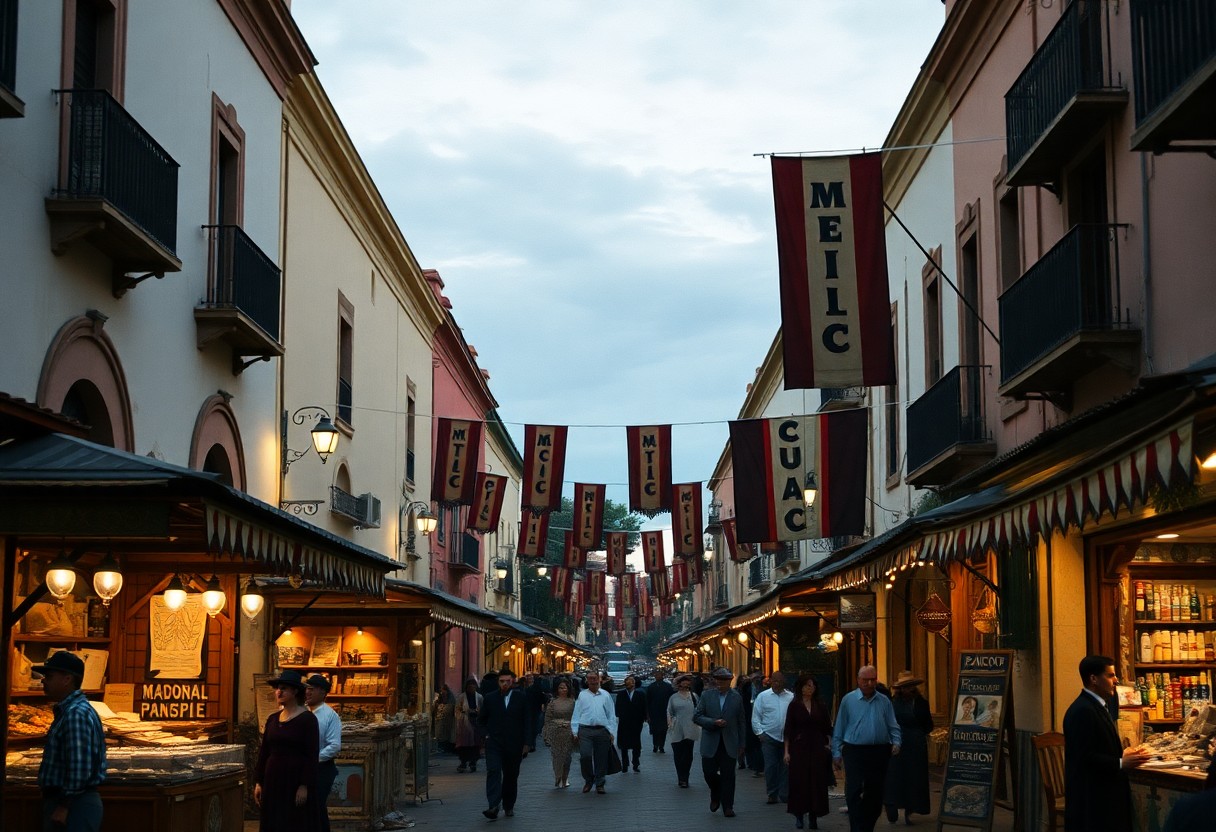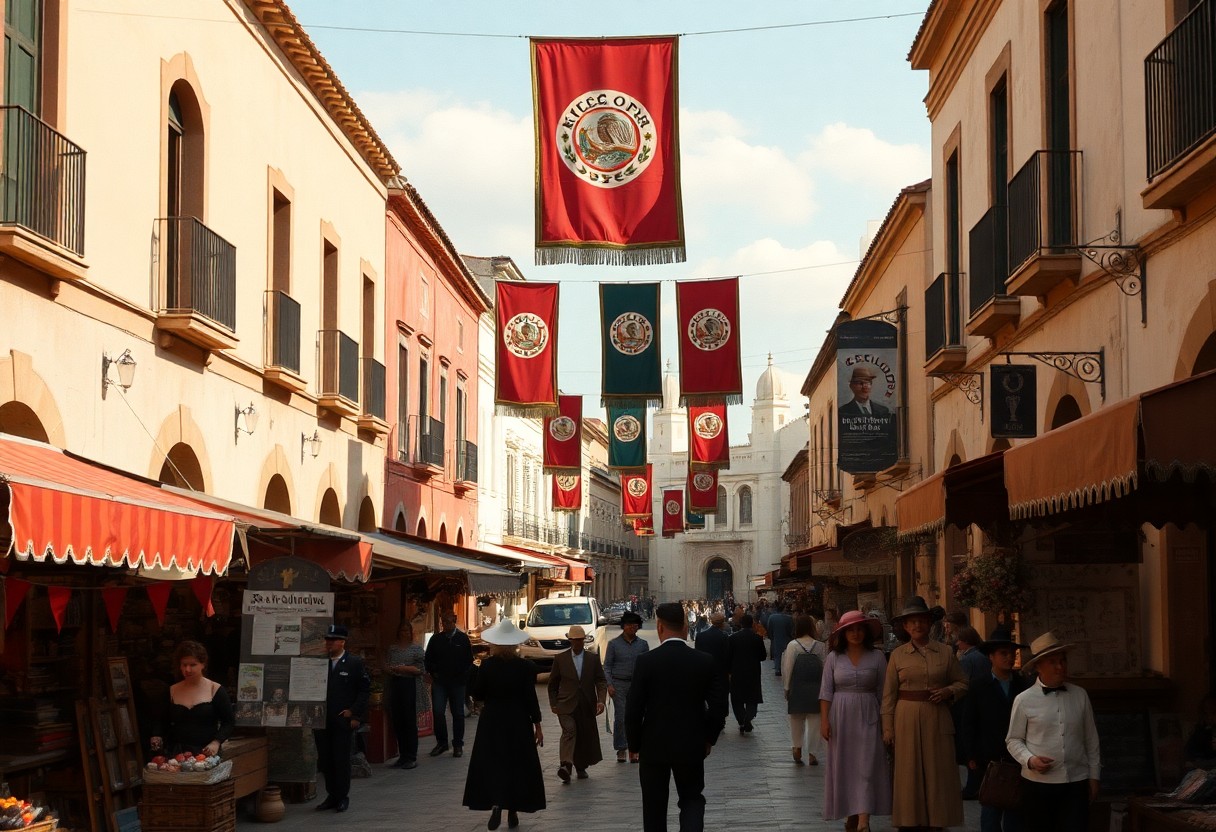On November 20, 1910, the Mexican Revolution erupted, dramatically reshaping the nation’s future and leaving a lasting legacy on cities like San Miguel de Allende. This pivotal uprising emerged as a response to severe inequality and oppressive governance, rallying iconic leaders such as Emiliano Zapata and Pancho Villa, who passionately fought for land rights and social justice. Today, the anniversary is celebrated with vibrant parades, reenactments, and a palpable sense of community pride, particularly in San Miguel de Allende, where the revolutionary heritage is deeply interwoven into local culture. Dive into how this significant historical event continues to influence life in this vibrant Mexican city.

Uncovering the Historical Roots and Context of the Mexican Revolution
The Mexican Revolution commenced on November 20, 1910, as a direct challenge to the lengthy dictatorship of Porfirio Díaz, whose oppressive regime lasted over three decades, favoring a wealthy minority while neglecting the struggles of the majority. Initially, the revolution served as a rallying cry for political reform but quickly transformed into a comprehensive movement tackling severe social and economic inequalities. Over the subsequent decade, the revolution significantly altered Mexico’s political landscape, culminating in the creation of the Constitution of 1917, a landmark document that remains a cornerstone of Mexican law and governance today.
Examining the Tyranny of Porfirio Díaz’s Regime
The regime of Porfirio Díaz was marked by profound social and economic inequality, as well as systemic oppression. Under his rule, wealth and land were concentrated in the hands of a privileged elite, while the majority of Mexicans faced poverty and hardship. Political dissent was brutally suppressed, and elections were manipulated to prolong his hold on power. This widespread discontent became the fuel for revolutionary fervor, as ordinary citizens demanded fair treatment, significant land reforms, and a sincere commitment to democratic governance. The struggle against Díaz evolved into a powerful symbol of the quest for justice and equality, striking a chord with the Mexican populace.
Francisco I. Madero: The Advocate for Democratic Change
The revolutionary movement found its passionate advocate in Francisco I. Madero, a reformist who boldly opposed the autocratic regime of Díaz. Madero’s influential work, The Presidential Succession of 1910, fervently argued for free elections and a decisive end to Díaz’s tyrannical rule. His famous slogan, “Effective Suffrage, No Re-election,”, resonated deeply with millions of Mexicans eager for change. Madero’s leadership sparked the initial uprising, and his election to the presidency in 1911 represented a pivotal moment in Mexico’s long and arduous struggle for democracy. Despite facing numerous challenges, Madero’s vision for an equitable society remains a vital part of the revolution’s enduring ideals.
Although Madero prioritized democracy, his presidency was marred by significant obstacles. Despite his sincere efforts to implement reforms, he struggled to unify the various revolutionary factions and maintain political stability. Tragically, his assassination in 1913 at the hands of General Victoriano Huerta’s loyalists marked a devastating blow to the revolutionary cause. Nonetheless, Madero’s ideals continued to inspire the ongoing fight for justice and equality throughout Mexico.

Honoring the Influential Leaders of the Mexican Revolution
To truly understand the Mexican Revolution, it is crucial to recognize the key figures whose leadership fundamentally shaped the battle for democracy, land reform, and social justice. Francisco I. Madero ignited the revolutionary spark, while Emiliano Zapata became a passionate advocate for peasant rights. Pancho Villa displayed remarkable military prowess as a commanding leader, and Venustiano Carranza was instrumental in drafting the transformative 1917 Constitution. Their collective actions not only redefined the course of Mexico but also left an indelible impact on San Miguel de Allende, where their legacies are celebrated each November 20th.
Francisco I. Madero: The Visionary Leader of Democratic Reform
The origins of the revolution can be traced back to Francisco I. Madero, a wealthy landowner who openly opposed the oppressive regime of Porfirio Díaz. Madero’s passionate call for democracy and fair electoral processes, articulated in his impactful book, The Presidential Succession of 1910, inspired countless individuals to join the revolutionary cause. His leadership culminated in the ousting of Díaz in 1911, although his presidency was tragically short-lived. Madero’s aspiration for a democratic Mexico remains a vital component of the revolution’s enduring ideals, symbolizing the ongoing struggle for a more just society.
Emiliano Zapata: The Advocate for Agrarian Reform
Emerging from the southern regions of Mexico, Emiliano Zapata became an iconic figure representing agrarian reform. His powerful slogan, “Tierra y Libertad” (Land and Freedom), resonated profoundly with peasants who had been dispossessed of their lands by wealthy landowners. Zapata’s Plan de Ayala called for comprehensive land redistribution, elevating him to a heroic status among the rural poor. His influence extended far beyond his immediate community, with his ideals still honored in San Miguel de Allende today.
Central to Zapata’s mission was his commitment to reform. He dedicated himself to restoring land to indigenous communities and small farmers, directly challenging the entrenched power of the elite. Although his assassination in 1919 marked a tragic end to his life, his enduring legacy continues to shape Mexico’s agrarian policies and is celebrated annually in San Miguel de Allende.
Pancho Villa: The Charismatic Revolutionary Leader from the North
Turning to Pancho Villa, the charismatic leader from the north is renowned for his bold military strategies and captivating personality. Villa commanded the División del Norte, a formidable army that played a crucial role in defeating federal forces. His victories, particularly the significant Battle of Zacatecas, were instrumental in shaping the course and outcomes of the revolution.
Villa distinguished himself through his ability to inspire unwavering loyalty among his troops and his tactical genius on the battlefield. Although his relationships with other revolutionary leaders were often fraught with tension, his contributions to the revolutionary cause are undeniable. In San Miguel de Allende, Villa’s legacy is celebrated with enthusiasm during the parades held on November 20th, reflecting the community’s deep respect for his role in the revolution.
Venustiano Carranza: The Visionary Behind the 1917 Constitution
To appreciate the lasting impact of the revolution, one must recognize Venustiano Carranza’s essential role. As a unifying leader, he skillfully brought together various factions and oversaw the drafting of the groundbreaking 1917 Constitution. This pivotal document introduced progressive reforms, including labor rights, land redistribution, and secular education, fundamentally shaping the future of modern Mexico.
While Zapata and Villa embodied the spirit of the revolution, Carranza served as its architect. His leadership ensured that revolutionary ideals were enshrined in law, paving the way for a more equitable society. In San Miguel de Allende, Carranza’s influence is commemorated as an integral part of the city’s rich historical narrative.

Defining Events that Shaped the Mexican Revolution’s Journey
Each significant event in the Mexican Revolution played a pivotal role in steering the nation’s future. From the overthrow of Porfirio Díaz to the drafting of the Constitution of 1917, these landmark moments represented substantial progress towards social and political transformation. They not only altered Mexico’s historical path but also left a lasting impact on regions like San Miguel de Allende, where the revolutionary ideals resonate deeply within the community.
The Historic Overthrow of Díaz: A Turning Point
When examining the revolution’s early phases, the overthrow of Porfirio Díaz in 1911 stands out as a monumental accomplishment. After decades of autocratic rule, Díaz’s resignation and subsequent exile marked a decisive turning point. This victory for revolutionaries like Francisco I. Madero ignited hope for democracy and reform throughout Mexico, including in San Miguel de Allende, where the echoes of this triumph are still felt today.
Emiliano Zapata and the Zapatista Movement: A Fight for Land Rights
No discussion of the revolution would be complete without acknowledging Emiliano Zapata and his relentless pursuit of agrarian reform. The Zapatista movement, which flourished in southern Mexico, embraced the rallying cry of “Tierra y Libertad” (Land and Freedom). This passionate quest for land rights had a profound impact on rural communities and has become an enduring symbol of resistance against oppression.
The events surrounding the Zapatista movement underscored the stark inequalities entrenched in Mexican society. Zapata’s Plan of Ayala called for comprehensive land redistribution, directly challenging the power held by affluent landowners. His legacy continues to inspire movements advocating for social justice, even in places like San Miguel de Allende, where his principles are actively commemorated.
The Battle of Celaya: A Pivotal Conflict in Revolutionary History
In 1915, the forces of Zapata and Villa faced a significant setback during the Battle of Celaya. This crucial conflict, led by Álvaro Obregón, marked a significant turning point in the revolution. Obregón’s innovative military strategies, including the effective use of trenches and machine guns, resulted in a decisive victory for Carranza’s forces, fundamentally altering the momentum of the revolutionary struggle.
The tactics employed during the Battle of Celaya highlighted the complex dynamics of the revolution. Obregón’s strategic innovations not only diminished Villa’s influence but also set the stage for Carranza’s leadership and the eventual drafting of the essential Constitution of 1917, which would shape Mexico’s legal and social framework for generations.
The Creation of the Groundbreaking Constitution of 1917
The events leading up to the establishment of the Constitution of 1917 were transformative, introducing a host of progressive reforms such as labor rights, land redistribution, and protections for workers. This historic document laid the essential groundwork for modern Mexico, establishing the legal and social principles that continue to govern the nation today.
A monumental achievement, the Constitution of 1917 addressed critical issues such as land reform and workers’ rights, with its effects resonating across the country, including in San Miguel de Allende. The constitution reinforced the revolutionary spirit, serving as a testament to the ongoing struggle for justice and equality in Mexican society.
Immersing in the Lively Celebrations of the Revolution
The celebration of November 20th in Mexico is marked by vibrant festivities that honor the significant legacy of the Mexican Revolution. Across the nation, communities engage in parades, reenactments, and cultural events that vividly bring history to life. In San Miguel de Allende, this day holds particular importance, with both locals and visitors actively participating in festivities that showcase the city’s deep-rooted connection to the revolution. From traditional costumes to spirited performances, these celebrations provide a unique opportunity to engage with Mexico’s rich history and culture.
National Parades and Historical Reenactments: A Vibrant Tribute
The national parades and reenactments stand out as a highlight of the November 20th celebrations. Schoolchildren don costumes representing revolutionary heroes such as Emiliano Zapata and Pancho Villa, marching proudly through the streets. Charros, or traditional Mexican cowboys, add an authentic flair to the festivities, while colorful floats and lively music create a jubilant atmosphere. These events serve not only to entertain but also to educate, ensuring that the sacrifices and achievements of the revolution are commemorated and honored.
Distinct Celebrations in San Miguel de Allende: A Unique Experience
One of the most unforgettable ways to experience November 20th is in San Miguel de Allende. The city’s celebrations are deeply intertwined with its revolutionary history, merging cultural pride with a strong sense of community spirit. Attendees can enjoy parades featuring traditional costumes, live music, and captivating performances that narrate the story of the revolution. The streets become a vibrant tapestry of energy, creating an ideal setting for immersing oneself in local customs and traditions.
In San Miguel de Allende, the celebrations acquire a distinctive character. The historic center of the city transforms into a bustling hub of activity, where locals and tourists gather to witness the parades and enjoy the festivities. Children dressed as figures from the revolution add a personal and heartfelt element to the historical reenactments. The atmosphere is both joyous and reflective, as the community takes time to honor the profound impact of the revolution on their lives. Expect large crowds and an energetic ambiance, as this day is one of the most anticipated events of the year in the city.
The Lasting Influence of the Revolution on San Miguel de Allende
Exploring the historical context reveals how the Mexican Revolution indelibly influenced San Miguel de Allende. Once a center for the affluent elite, the city evolved into a hub of social reform and cultural renaissance. The revolutionary ideals of equality and justice fundamentally transformed its identity, nurturing a sense of community and shared purpose that continues to define the city today.
Deep Social and Cultural Transformations
The social changes initiated by the revolution left a profound impact on San Miguel de Allende. Land reforms empowered local farmers, reducing the control of large estates over the community. Culturally, the city embraced its indigenous heritage, merging traditional practices with revolutionary ideals to craft a unique cultural identity. This fusion is evident in the vibrant festivals, artistic expressions, and architectural styles that enrich the cultural landscape visitors can explore today.
The Enduring Legacy of Revolutionary Ideals in San Miguel de Allende
The most enduring impacts of the revolution resonate through San Miguel de Allende’s unwavering commitment to equality and education. The city emerged as a model for progressive reforms, with schools and community initiatives reflecting the revolution’s emphasis on social justice and empowerment. These ideals resonate with both residents and visitors, making the city a living testament to the revolutionary spirit.
The revolutionary ethos exemplified by figures like Miguel Hidalgo continues to thrive in San Miguel de Allende. The city’s land reforms and educational advancements are direct outcomes of the revolution’s influence. However, the pursuit of equality has also brought challenges, including periods of conflict and instability. Despite these obstacles, the city has emerged as a symbol of resilience, seamlessly blending its revolutionary past with a vibrant present. Today, visitors can witness this legacy in its flourishing arts scene, historic landmarks, and a strong sense of community that honors its roots.
Understanding the Contemporary Significance of the Mexican Revolution
To fully grasp the importance of the Mexican Revolution, one must recognize its foundational role in shaping modern Mexico. The revolution transformed the nation’s political, social, and economic landscapes, establishing a framework for democracy and social justice. Its legacy continues to influence Mexico’s identity, serving as a powerful reminder of the necessity of collective action and the ongoing need to confront inequality. In San Miguel de Allende, the revolution’s impact is vividly reflected in the community’s cultural pride and spirit of solidarity, making it a living testament to the enduring relevance of this historic event.
Timeless Lessons in Democracy and Social Justice
Even in contemporary society, the Mexican Revolution imparts crucial lessons about the importance of democracy and the relentless pursuit of social justice. The revolution’s leaders, including Emiliano Zapata and Francisco Madero, passionately advocated for land reform and political freedom—ideals that remain central to Mexico’s national identity. Their formidable struggles remind us that genuine progress often requires sacrifice and unity, insights that resonate with modern movements advocating for equality and fairness worldwide.
The Revolution’s Lasting Influence on Mexico’s Modern Landscape
Today, the concept of democracy in Mexico owes much to the revolution’s legacy. The Constitution of 1917, born from the revolutionary struggle, instituted groundbreaking reforms related to labor rights, land distribution, and education, shaping the contours of modern Mexican society. In San Miguel de Allende, the revolutionary spirit continues to thrive through its vibrant culture and strong sense of community, reflecting the far-reaching impact of this transformative era.
Insights gained from the revolution highlight both its positive and challenging aspects. While it catalyzed significant reforms, the decade-long conflict also inflicted immense suffering and loss. The revolution’s legacy serves as a poignant reminder that progress often comes at a cost, yet its ideals of justice and equality continue to inspire. In San Miguel de Allende, one can observe how these principles have shaped a city that values its history while embracing the possibilities of modernity.
Appreciating the Significance of November 20th in Mexican History
History shows that November 20th carries immense significance in Mexico, marking the dawn of the Mexican Revolution. This event not only reshaped the nation’s socio-political landscape but also addressed critical inequalities, with its legacy continuing to resonate in San Miguel de Allende today. By exploring the revolution’s origins, influential figures, and vibrant celebrations, you gain valuable insights into Mexico’s cultural identity and its ongoing journey toward equality. In San Miguel de Allende, the day is celebrated with parades and reenactments, offering a unique opportunity to connect with the city’s rich heritage. Seize this chance to delve into and appreciate the lasting impact of the revolution on this historic community.
Common Inquiries Regarding the Mexican Revolution
Q: What does November 20th symbolize in San Miguel de Allende?
A: November 20th commemorates the anniversary of the Mexican Revolution, a pivotal milestone in Mexico’s history. In San Miguel de Allende, this day is celebrated through parades, reenactments, and public events that honor the revolution’s enduring legacy. The city comes alive with vibrant displays of traditional attire, charros, and schoolchildren portraying key revolutionary figures, fostering a profound sense of community and pride.
Q: Who were the key figures in the Mexican Revolution, and how did they influence San Miguel de Allende?
A: The course of the Mexican Revolution was significantly shaped by leaders such as Francisco I. Madero, Emiliano Zapata, Pancho Villa, and Venustiano Carranza. Their dedicated efforts to promote political reform, land rights, and social justice left a lasting legacy across Mexico, including in San Miguel de Allende. The city’s celebrations honor the ideals of these leaders, emphasizing democracy, equality, and a strong community spirit.
Q: How does San Miguel de Allende celebrate the Mexican Revolution on November 20th?
A: San Miguel de Allende celebrates November 20th with vibrant parades, cultural performances, and historical reenactments. The streets of the city are filled with participants dressed in traditional attire, showcasing the revolution’s enduring themes of freedom and justice. Schools and local organizations often organize events aimed at educating residents and visitors about the historical significance of the revolution and its impact on contemporary society.
The Article: November 20th: Understanding the Mexican Revolution and Its Impact on San Miguel de Allende appeared first on https://fallinginlovewithsanmiguel.com/
The Article Mexican Revolution’s Impact on San Miguel de Allende: Nov 20th Insights Was Found On https://limitsofstrategy.com

